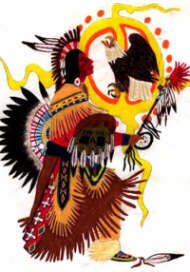![]()
|
|
|
|
|
|||||

Success Stories
A unique aspect of First Nations' culture now on the Interne
Since the 1970s, various organizations have been archiving and collecting resources on the First Nations of the Great Plains. In order to further educate Canadians on their history and their culture, First Nations People have taken advantage of opportunities to digitize aspects of their heritage on the Internet. Under contract to Industry Canada's SchoolNet Digital Collections program, which hires youth between the ages of 15 to 30 to digitize Canadian content, five students from Nutana Collegiate Institute in Saskatoon, Saskatchewan have brought the Games of the Plains Cree, a 1985 publication compiled by Pat Atimoyoo, to a new and exciting medium.
The Games of the Plains Cree collection explains, through the use of illustrations, texts, video and audio, various types of games practised by the Plains Indians. The site is divided into different categories such as chance games, ball games, toys and miscellaneous games. Each section describes the object of the game, the materials required to play and also explains game variations according to the different tribes.
Ronald Bernston, librarian at the Nutana Collegiate Institute of the Saskatoon Board of Education and project co-ordinator for the web site, decided to use Pat Atimoyoo's book as the basis of the site for two reasons. First, the book was locally produced and therefore significant to the community. Secondly, since 35% of the Nutana Collegiate Institute population is Native, the young team would be able to relate to the content about to be digitized. In fact, many of the team members had a good understanding of these games, having played them at Pow-Wows or with family members. By digitizing the 1985 publication for the Web and thus adding interactive components to enhance the content, the Games of the Plains Cree drastically improved its availability and instantly targeted a wider audience.
The Nutana Collegiate Institute team consisted of young individuals who could benefit from a positive work experience. These students either had little or no work experience at all. This project offered the students the opportunity to work within a positive environment where today's important computer and web design skills were emphasized. As Bernston says, quoting one of the students: "(this work opportunity) doesn't seem as dead end... and it sure beats waitering!"
While the acquisition of web design skills were useful for the students, Bernston really wanted to inspire creativity and promote communication within the team. "I wanted them to realize the potential of technology in order to communicate innovatively and effectively," he says. For him, the technological skills accumulated during the production of the site were secondary to lifelong rewards of building a student's confidence and giving him/her "an opportunity to have a positive real life working experience."
The young team consisted of these five members: Elliot Bear, Dominic Morgan, Don Shelby, Brad Stone and Sean Lessard. Together, with their newly acquired web site development skills, their previous knowledge of Cree games and their new found confidence, the team devised an interesting and well planned site that can be integrated in school's history and social studies curricula. Most importantly, the project gave the team a positive work experience that reinforces the First Nations people's pride in their rich and unique cultural heritage while offering Canadians a little known piece of First Nations' culture.
Visit the SchoolNet Digital Collections World Wide Web Site at http://collections.ic.gc.ca
|
Updated: |
 The Games of Plains Cree
The Games of Plains Cree